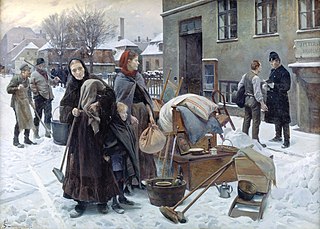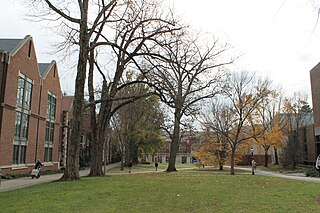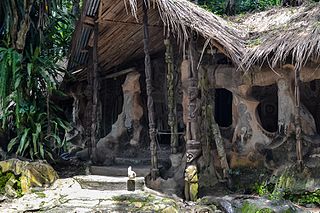
Eviction is the removal of a tenant from rental property by the landlord. In some jurisdictions it may also involve the removal of persons from premises that were foreclosed by a mortgagee.

Biennale, Italian for "biennial" or "every other year", is any event that happens every two years. It is most commonly used within the art world to describe large-scale international contemporary art exhibitions. As such the term was popularised by Venice Biennale, which was first held in 1895. Since the 1990s, the terms "biennale" and "biennial" have been interchangeably used in a more generic way - to signify a large-scale international survey show of contemporary art that recurs at regular intervals but not necessarily biannual. The phrase has also been used for other artistic events, such as the "Biennale de Paris", "Kochi-Muziris Biennale", Berlinale and Viennale.

Ikoyi is the most affluent neighborhood of Lagos, located in Eti-Osa Local Government Area. It lies to the northeast of Obalende and adjoins Lagos Island to the west, and at the edge of the Lagos Lagoon. Popular with the extreme upper class residents of Nigerian society, Ikoyi is arguably one of the wealthiest communities within Nigeria.

Human rights in Nigeria are protected under the current constitution of 1999. While Nigeria has made major improvements in human rights under this constitution, the American Human Rights Report of 2012 notes several areas where more improvement is needed, which includes: abuses by Boko Haram, killings by government forces, lack of social equality and issues with freedom of speech. The Human Rights Watch's 2015 World Report states that intensified violence by Boko Haram, restrictions of LGBTIQ rights and government corruption continue to undermine the status of human rights in Nigeria.

Seasteading is the concept of creating permanent dwellings at sea, called seasteads, in international waters outside the territory claimed by any government. No one has yet created a structure on the high seas that has been recognized as a sovereign state. Proposed structures have included modified cruise ships, refitted oil platforms, and custom-built floating islands.

Makoko is an informal settlement across the 3rd Mainland Bridge located on the coast of mainland Lagos. A third of the community is built on stilts along the lagoon and the rest is on the land. The waterfront part of the community is largely harboured by the Egun people who migrated from Badagary and Republic of Benin and whose main occupation is fishing.

LagosPhoto Festival is the first international art festival of photography in Nigeria, launched in October 2010. It is organised by the African Artists’ Foundation (AAF) as part of an ongoing project designed to use art in public spaces, as a medium for increasing societal awareness. The festival includes workshops and classes for professional artists, art fairs and indoor and outdoor exhibitions citywide. LagosPhoto is held annually and features emerging photographers alongside established photographers.
Kunlé Adeyemi was born on the 7 April 1976 and is a Nigerian architect, urbanist and creative researcher. Adeyemi is founder and principal of NLÉ, an architecture, design and urbanism practice, based in Amsterdam, in the Netherlands. Adeyemi studied at the University of Lagos in Nigeria and Princeton University in New Jersey, the United States. Before starting his own office in the Netherlands, he worked nearly a decade at Office for Metropolitan Architecture (OMA).
The following is a timeline of the history of the metropolis of Lagos, Nigeria.

Alejandro Gastón Aravena Mori is a Chilean architect and executive director of the firm Elemental S.A. He won the Pritzker Architecture Prize in 2016, and was the director and curator of the Architecture Section of the 2016 Venice Biennale.
Emmanuel Olakunle Filani is a Nigerian educator and artist. His works are closely identified with the school of thought named Onaism, an art movement that is based on the fusion of the designs, ornamentation and motifs found in traditional Yoruba carvings and textiles with modern art pieces such as drawings and paintings. Filani is also a lecturer and an administrator – he was a provost of the Federal College of Education, Osiele, Abeokuta.

Deyemi OkanlawonListen is a Nigerian film, television, theatre and voice actor. He is best known for his roles in Omo Ghetto: The Saga, Blood Sisters and King of Boys: The Return of the King. He has been listed as the highest grossing Nollywood actor of 2020 and 2021.
Ekundayo Adeyinka Adeyemi was a Nigerian architect and academic who was a distinguished professor of architecture at Covenant University, Ota. In 1975, Adeyemi attained professorship at Ahmadu Bello University, Zaria a promotion that made him the first professor of architecture in Nigeria and Sub-Saharan Africa. He was acting vice chancellor of the Federal University of Technology Akure from December 1999 to September 2001.

Princeton University School of Architecture is the name of the school of architecture at Princeton University. Founded in 1919, the School is a center for teaching and research in architectural design, history, and theory. The School offers an undergraduate concentration and advanced degrees at the master's and doctoral levels.
Architecture of Nigeria was historically influenced by environmental conditions as well as social and cultural factors. The coming of missionaries and political changes brought about by colonialism precipitated a change in architectural style and utility of buildings. A Gothic revival style was adopted for early churches built in the colony of Lagos. A one or two storey timber house building made with pre-fabricated material components and designed with the influence of classic antiquity styles served as mission house for the missionaries. Colonial residents working for the Public Works Department introduced a variant of neoclassical architecture to designs of government buildings and private residencies.
Mohammed Elshamy is an Egyptian photojournalist based in Lagos and New York.

Squatting in Nigeria refers to a person who is not the owner, taking possession of land or an empty house. Squatters migrate from the countryside to informal settlements in cities such as Abuja, Port Harcourt and in particular Lagos. Lagos had a population of over 14 million people in 2019 and many slums, including Makoko.

Yoruba architecture describes the architectural styles of the Yoruba people of West Africa, dating back to approximately the 8th century. and lasted up to and beyond the colonial period beginning in the 19th century CE.
Tunde Onakoya is a Nigerian chess master, coach and founder of Chess in Slums Africa. He has organized a number of interventions for children across slums in Lagos state including Majidun (Ikorodu), Makoko and recently, Oshodi. The children are engaged in a 2 week's session that seeks to unlock their potential through the game of chess while learning to read, write and acquire basic literacy skills.
Olufela Omokeko is a Nigerian contemporary multimedia artist who works in performance, installation and photography. Born and based in Iwaya waterfront community in Lagos, Olufela is the artistic director of Slum Makers Art Project (X-MAP) in Makoko, and the co-cultural producer of the annual Iwaya Community Art Festival in Lagos.












